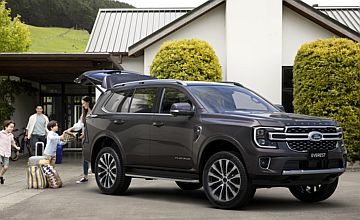Make / Model Search
OptionsCar reviews - Ford - Everest - PlatinumFord modelsResearch Ford OverviewWe like Excellent engine performance; well calibrated dynamics; quiet and roomy cabin; generous equipment; sensible ADAS calibration; competent on-road, off-road and when towing Room for improvement Busy transmission; can be thirsty; headlight performance is average at best; some HMI functions are complex to access, including those for disabling more annoying ADAS features Ford’s Everest Platinum flagship delivers a high level of comfort and impressive control30 Jul 2025 Overview
HERE’S the rub, you can buy a top of the whizzer, 3.0-litre V6 diesel Ford Everest Platinum large segment luxury SUV for a not insignificant $81,200 excluding on-road costs or a lower spec, Toyota LandCruiser Prado GXL 2.8-litre diesel four-cylinder for a snip under $80K..
The former has 184kW/600Nm the latter 150kW/500Nm.
It’s a difficult decision especially as Toyota owns the outback and has high resale values particularly the LandCruiser Prado but more power and torque is an attractive proposition with the Everest.
After driving the square-set Everest Platinum we can’t really make a definitive decision either way as the Ford is such a well-rounded product… as is the Toyota LandCruiser Prado.
Other makes have tempting alternatives too such as the top of the range Isuzu MU-X (from $74,400) or you could always look at a soft roader if you aren’t fair dinkum about off-roading.
The Everest Platinum is all at once luxurious, practical, kind of handsome apart from the “C-clamp” headlights, extremely well calibrated dynamically and the engine goes like a train using not too much fuel into the bargain.
It has a wider track and longer wheelbase than its predecessor requiring a “more dramatic swell” over the wheels, contributing to a dominant stance but also improving its ride on- and off-road.
From the seat of the pants, you would not think the Everest was built on a ladder frame based on its comfort levels and chassis control due to the all-coil spring suspension with double wishbones at the front and Watts linkage at the rear with Bilstein dampers all round.
That 3.0-litre mill has been around for yonks and has a timing chain rotating the dual overhead cams, not a contentious wet belt (that runs through sump oil) like the bi-turbo 2.0-litre in lesser Everest/Ranger.
It drives all four wheels constantly through a 10-speed automatic transmission offering six drive modes, four for sealed roads and two for doin’ it in the dirt.
The Everest’s four-wheel-drive system features an electronically controlled transfer case for off-road duties and assists in providing those six drive modes.
Cool kit on the Everest Platimum includes a12-speaker Bang & Olufsen premium sound system, a 12.4-inch digital driver’s display, matrix LED headlights (with auto-levelling), active park assist, 360-degree camera, tyre pressure monitoring, 21-inch alloy wheels, third-row electric folding seats 50:50 split.
On the comfort side it scores quilted leather-accented seats (including in the third row), 10-way power adjust driver seat with memory setting, 10-way power adjust passenger seat, heated and cooled front seats, heated second-row seats a panoramic sunroof, and black painted roof.
A comprehensive safety suite comprises active and passive features and an extensive array of ADAS.
Interior styling reflects a modern tech-rich idiom offering more room than before and premium feel surfaces and is dominated by a large portrait style centre screen for vehicle functions and infotainment.
Behind the multi-function wheel, a smaller 12.4-inch digital widescreen provides info’ to the driver.
Drive Impressions
We’d heard the current model Everest was well endowed dynamically and concur, such is definitely the case as demonstrated across all types of driving and driving environments where the big, luxury SUV makes light work of delivering a high level of comfort and impressive control.
The suspension provides a smooth, stable ride through all six drive modes and is particularly adept in tough off-road driving, rock hopping and negotiating deep ruts exhibiting decent wheel articulation with adequate grip from the standard fit big AT tyres.
There’s plenty of ground clearance and short overhangs so you won’t become tangled up off road while low range enables crawl speed in dodgy driving environments.
Gravel roads are a cinch, and the Everest Platinum is super capable in the sand as long as the tyres are deflated to around 14psi.
We weren’t able to assess it on ice or in the mud but suggest it would make a good fist of the slippery stuff given the drive system, torquey engine and decent tyres.
The vehicle’s all-round capabilities are enhanced by its high traction constant 4x4 system and the Platinum’s electronic locking rear diff’ which provides drive even in the most arduous conditions.
Moving to sealed road driving we found the test vehicle is similarly competent with, once again a supple and controlled ride, impressive bump absorption and sound attenuation and absolutely no deflection or bump steer on rough surfaces, the steering itself quite communicative and well weighted for a fourbie.
Though it’s drawing a long bow, in Sport mode you could almost be driving a sports SUV if it weren’t for the high ride height and porky 2514kg tare weight.
Using the Tow/Haul mode we hooked up a car trailer to the test model and it was like a jet up-hill providing actual acceleration on steep climbs and then relaxed cruising on the flat with fuel use hovering around the 12.9 litres per 100km mark hauling a 2000kg trailer.
The Everest is rated at a maximum 3500kg towing (braked), but we reckon that is really pushing it and may be detrimental to the vehicle over a longer term.
Plenty of power percolates from the 3.0-litre turbodiesel V6 giving the Everest Platinum a good turn of speed right from a stop through to high-speed driving with the 10-speed auto coming into its own.
However, with that many cogs in the ‘box, the Everest seems to be always changing gear as it may be optimising fuel economy that rated a best of 8.0L/100km… metaphorically driving with an egg underfoot.
At that fuel usage, the Everest may have a range of 800km.
We loaded it up with seven peeps which made little difference to the vehicle’s performance or ride which remained supple and cossetting with plenty of kick still available from the torquey V6 turbodiesel.
We drove it on a long weekend away and the big Ford proved both comfortable and not in the least bit tiring over 800kms of continuous country driving.
It provides a high level of luxury starting with the quilted leather seats and ending with the monumental B&O audio system with everything you need in between and the ADAS is only mildly annoying.
Would we buy one?
Unequivocally yes for the V6 in any spec’, no for the 2.0-litre bi-turbo for the “wet belt” reasons mentioned above.
 Read more3rd of June 2025  Everest PHEV possible, but unlikely says FordWhile a Ford Everest PHEV is technically possible, the business case may not stack up22nd of May 2025  Ford Everest Black Edition debutsLimited edition Ford Everest Black Edition now available from $69,900 d/a4th of March 2025  Everest Tremor to decimate local salesOff-road Tremor expected to account for one-in-10 Ford Everest sales in Australian marketAll car reviews Alfa Romeo Alfa Romeo Abarth Abarth Audi Audi Aston Martin Aston Martin BMW BMW Bentley Bentley Chrysler Chrysler Chevrolet Chevrolet Dodge Dodge Citroen Citroen Ferrari Ferrari DS DS Ford Ford Fiat Fiat FPV FPV Foton Foton Haval Haval Great Wall Great Wall Honda Honda Holden Holden Hyundai Hyundai HSV HSV Isuzu Isuzu Infiniti Infiniti Jaguar Jaguar Iveco Iveco Kia Kia Jeep Jeep Land Rover Land Rover Lamborghini Lamborghini Maserati Maserati Lexus Lexus McLaren McLaren Mazda Mazda Mercedes-Benz Mercedes-Benz Mitsubishi Mitsubishi Mini Mini Opel Opel Nissan Nissan Porsche Porsche Peugeot Peugeot Ram Ram Proton Proton Rolls-Royce Rolls-Royce Renault Renault Skoda Skoda Saab Saab SsangYong SsangYong Smart Smart Suzuki Suzuki Subaru Subaru Toyota Toyota Tesla Tesla Volvo Volvo |
OptionsClick to share
|











Facebook Twitter Instagram